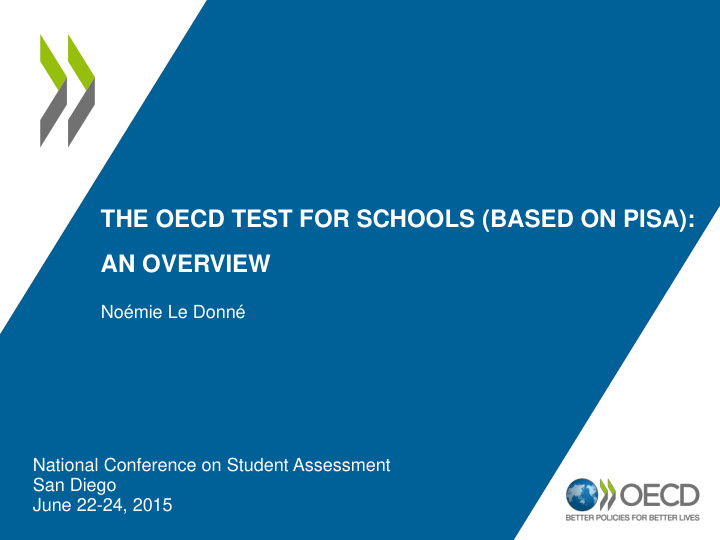



THE OECD TEST FOR SCHOOLS (BASED ON PISA): AN OVERVIEW Noémie Le Donné National Conference on Student Assessment San Diego June 22-24, 2015
WHAT IS PISA?
PISA’s unique features • Target population: 15-year-old students • Innovative concept of « literacy » • Relevance of lifelong learning • Regularity • Breadth of coverage • Policy orientation
WHAT IS THE OECD-TEST FOR SCHOOLS?
The OECD Test for Schools • Developed by the OECD • Based on PISA • For use by schools and groups of schools • To support research, international benchmarking and school improvement efforts
Who participated in the assessment? • United States – More than 400 schools since 2013 across about 30 states • United Kingdom – About 100 schools participated in 2014/15 • Spain – 225 schools participated in the 2013 pilot • Other interested countries: Argentina, Australia, Japan, Turkey, Brunei, Greenland
What is the test like? • Paper-based test (2 hours) assessing students’ skills in reading, mathematics and science • Student background questionnaire (30 minutes) • School background questionnaire (few minutes)
How is the test conducted? • Appointment of a school coordinator in each participating school • Random selection of 85 students from a list of eligible students in the school • Testing session conducted by a test administrator • Coding and processing of the data conducted by the national service provider • Preparation of a school report
WHAT KIND OF RESULTS DOES THE TEST PROVIDE?
The school report How your school compares internationally OECD Test for Schools 2014 - 2015 School name School District State United States
Key features of the school report • International comparisons
Key features of the school report • International comparisons
Key features of the school report • Close look at students’ performances
Key features of the school report • Close look at students’ performances Lower score limit What students can do at this level of proficiency Level on PISA scale At proficiency Level 6, students can consistently identify, explain and apply scientific knowledge and knowledge about science in a variety of complex life situations. They can link different information sources and explanations and use evidence from those sources to justify decisions. They clearly and 6 669 consistently demonstrate advanced scientific thinking and reasoning, and they demonstrate willingness to use their scientific understanding in support of solutions to unfamiliar scientific and technological situations. Students at this level can use scientific knowledge and develop arguments in support of recommendations and decisions that center on personal, social or global situations. At proficiency Level 5, students can identify the scientific components of many complex life situations; apply both scientific concepts and knowledge about science to these situations; and can compare, select 5 607 and evaluate appropriate scientific evidence for responding to life situations. Students at this level can use well-developed inquiry abilities, link knowledge appropriately and bring critical insights to situations. They can construct explanations based on evidence and arguments based on their critical analysis.
Key features of the school report • Close look at students’ performances Lower score limit Level What students can do at this level of proficiency on PISA scale At proficiency Level 2, students have adequate scientific knowledge to provide possible explanations in familiar contexts or draw conclusions based on simple investigations. They are capable of direct reasoning and making literal interpretations of the results of scientific inquiry or technological problem solving. 2 420 PISA considers Level 2 a baseline level of proficiency at which students begin to demonstrate the science competencies that will enable them to participate actively in life situations related to science and technology.
Key features of the school report • Close look at students’ performances
Key features of the school report • Comparison with similar schools with regards to social background
Key features of the school report • Comparison with similar schools
Key features of the school report • Analyses of student engagement and school learning environment: – disciplinary climate in English and mathematics lessons – teacher-student relations – instrumental motivation in mathematics and science – self-concept in mathematics and science – reader profiles • And how they associate with students performances
Key features of the school report • Analyses of student engagement and school learning environment: – disciplinary climate in English and mathematics lessons – teacher-student relations – instrumental motivation in mathematics and science – self-concept in mathematics and science – reader profiles • And how they associate with students performances
Teacher-student relations
Case stories
FUTURE PLANS
Future plans • Development of a template for district-level reporting • Development of an online version of the test
THANK YOU! Noémie Le Donné National Conference on Student Assessment San Diego June 22-24, 2015
Recommend
More recommend